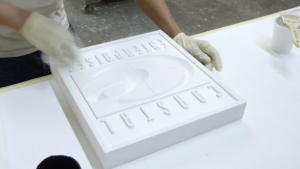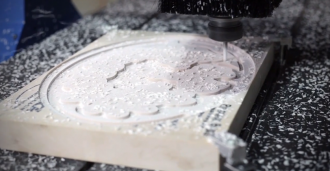Precision Board HDU, or high density urethane, is a sign substrate used in place of wood and other materials, because neither moisture nor temperature can enter Precision Board and it is available in an abundance of sizes and densities.
While it is a state-of-the-art sign substrate, there are some subtle tips and tricks that can be exploited to help make your HDU experience more efficient.
1. Don’t sand in-between coats of primer! Apply all the coats of primer to your Precision Board sign and do one final sanding. If you’re using FSC-88WB, it should powder when you start sanding. See our priming blog here.

2. Save your scraps. Scrap pieces of HDU can be bonded together with an adhesive to make a sign blank or sculpting medium. Additionally, if your sign is damaged, it’s also possible to repair the damage using a piece of scrap HDU and some adhesive.

3. The right cutting bit, speeds and feeds make all the difference as to how much time it will take for your sign to finish on the CNC router. Using the proper cutting bit, speeds and feeds lets you achieve optimal chip load. Proper chip loads allows for quicker insertion/removal of the tool, which help increase CNC efficiency.

4. Adding texture to a sign can be quite time-consuming. If you don’t have time to carve or rout your desired texture, TSF-45 and PB Hardcoat both provide great time-saving alternatives for adding wood grain or other texture.
 See the full article about this sign here.
See the full article about this sign here.
5. Help speed up the drying of your primer by placing a large shop fan to blow air across the primed signs. Air moving across the surface creates a slight frictional heating which pulls out the solvent or water carrier that is in the primer.
Don’t forget, Coastal Enterprises offers free tech support! Call us at: (800) 845-0745 with your questions.